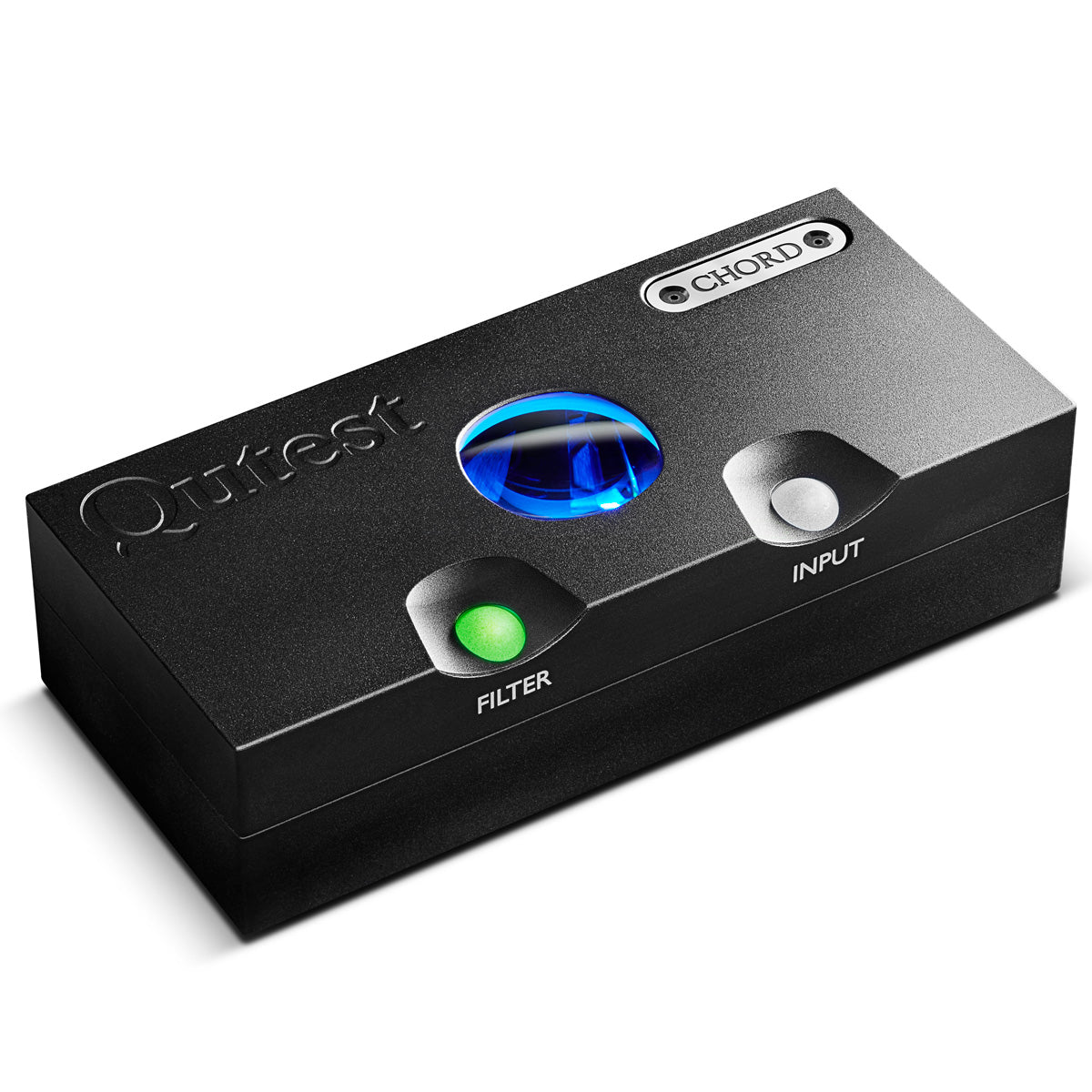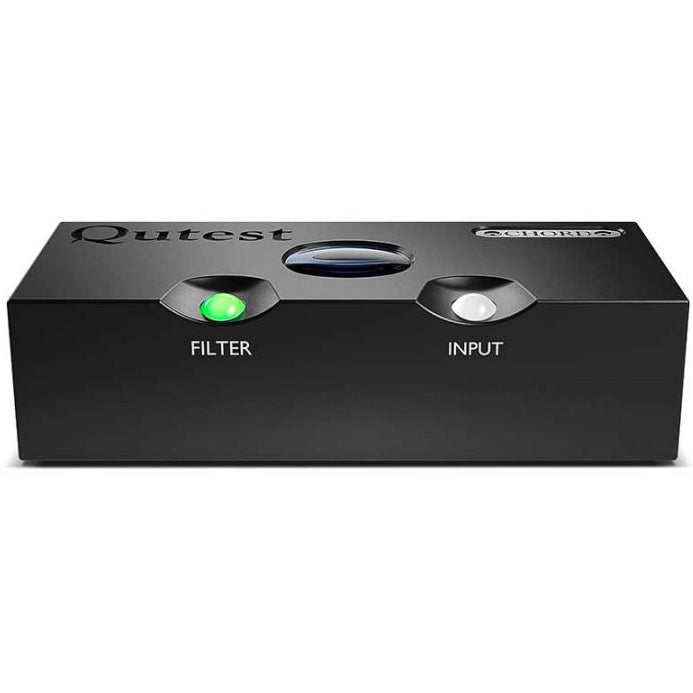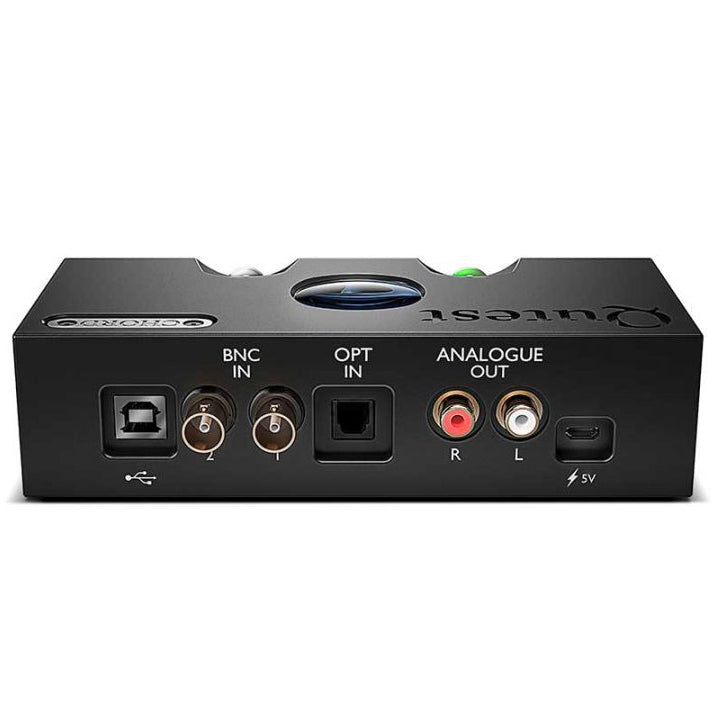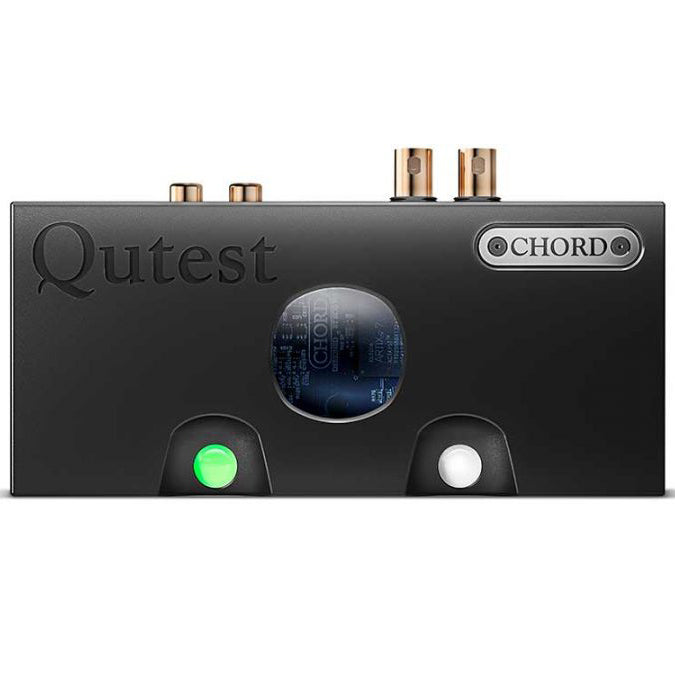Chord Electronics Qutest
Couldn't load pickup availability
Free Shipping On All Orders, No Minimums.
We offer free 2-day shipping on most products within the continental US.
Weekdays - Orders placed by 2pm EST ship same day. Orders placed after 2pm EST will ship the following business day.
Weekends - Orders placed on Saturday and Sunday will ship Monday.
Orders requiring motor freight delivery may take more than two business days. Once your order has shipped, you'll receive a shipping confirmation email with a tracking number for easy tracking.
Orders that contain items that are currently backordered, special order, or out of stock will ship complete once all items are in-stock unless otherwise requested.
If you need it faster, you will have the option of choosing a quicker shipping option when you checkout on the website.
At this time, we do not ship internationally and orders to Hawaii and Alaska may incur an additional shipping charge. Please contact us at 888.899.8776 or email support@audioadvice.com to confirm.
Rerouting and Address Changes
We cannot make ANY address changes once an order is placed. If you are unable to accept delivery of your package as ordered, we will need to cancel your order, return the package to sender and have you replace your order through our website.
Keep the Box
We suggest you keep the shipping box or boxes for at least 30 days. It is actually a great idea to keep boxes for audio products for the life of the product. Having the box and all packing will increase the trade-in value should you decide to move up and they are handy to have should you ever need to send the unit in for repair.
How To Receive a Motor Freight Order
The trucking company will contact you to schedule a convenient time to deliver the order. Please note that you must be present for delivery.
Visually inspect the box to make sure you see no signs of damage. If you notice any damage at all, take some pictures with your phone and make a note of them on the delivery receipt the driver will ask you to sign. If it is obvious that the product is damaged, please refuse the order and contact us immediately at 888.899.8776 or email support@audioadvice.com.
Open your box as soon as possible and inspect the product for damage and contact us if you find anything wrong.
uShip In-Home Delivery
Due to current concerns surrounding COVID-19, uShip is able to offer THRESHOLD SERVICE ONLY at this time. To ensure everyone’s safety, uShip is advising carriers to refrain from making room-of-choice deliveries. Threshold service consists of the shipment being brought into the first door of the address or the lobby of an apartment/condo, and does not include set-up, installation, assembly or debris removal.
What to Expect: Most oversized items will be delivered within 2-3 weeks. Your carrier will place your item inside the first door of the address or the lobby of an apartment/condo.
Appointment Scheduling: Your delivery partner will call 24-48 hours prior to delivery to arrange an appointment window.
How to prepare for in-home delivery:
- Determine the clearest path from the street to your home
- Measure entrances and hallways to ensure your item will fit
- Remove any wall hangings or clutter to ensure a clear path and to prevent damages
- Remove old furnishings to allow placement for your new piece
Check your furniture for damages: We rarely expect damaged furniture, but in the instance it does happen, we have you covered. Once your item’s packaging is removed, check for any damages that may have occurred in transit. Take pictures of any damages and notate appropriately on the delivery receipt. Keep possession of the damaged piece and contact us via phone or email and we’ll start the process to repair/replace your new piece of furniture. For uShip customer support, please call 800-698-7447.
At Audio Advice, we pride ourselves on customer satisfaction. We'll bend over backward to make sure you're 100% satisfied and we won't accept anything less. We offer 30-day hassle-free returns and personalized service from real, live people.
If an item doesn't meet your expectations, you may return or exchange it in its original condition and packaging within 30 days for a full refund, minus shipping fees. Items shipped back in like new condition through standard shipping carriers will only incur a flat fee of $15 to return. If the items were initially shipped through free scheduled delivery via motor freight (commonly referred to as LTL), returning them will result in return shipping fees starting at $150. These items include but are not limited to, oversized items such as TVs, certain subwoofers, floorstanding speakers, furniture, and most items weighing over 75 pounds. Return fees will also apply for exchanges. We want to treat your system as if it is our own and want you to be completely satisfied with your purchase.
Please see the instructions below. We only accept returns for any product purchased directly from our website. If merchandise is not returned in its original condition or is missing packaging, manuals, accessories or other parts, or the resale value of the product has been impaired, a partial refund will be given and calculated on a case-by-case basis.
Non-Returnable Items
The following items cannot be returned or cancelled:
- Special/Custom Order Items
- Open Box Products
- Gift Cards
- In-ear headphones cannot be returned once the packaging has been opened due to personal hygiene reasons. Please contact our customer care team if you'd like help choosing.
-
Turntables With a Broken Stylus: All turntables ship out with the stylus intact. If you return a turntable or phono cartridge with a broken or missing stylus you will be subject to a return fee. Please be careful when setting up your turntable and contact us with any questions.
Is It Easy To Return An Item?
Yes, simply give us a call at 888.899.8776 or you can email our support team at support@audioadvice.com. Many times our team of experts can help figure out why the product might not be working like you expected and get things fixed over the phone, so don’t be surprised if we ask a few questions, we love troubleshooting!
If our tech help can not make you happy, we will email over a return shipping label with a Return Number.
Hopefully, you saved all of the original item’s box and packaging inserts. You will want to pack back up your return or exchange in the same way it came out of the original box. Once you have everything packaged correctly, tape the box on the top and bottom to assure it stays together. If Audio Advice shipped the item to you inside a second box, it's a good idea to use that same extra box to help prevent damage on its way back to us. To avoid it accidentally coming back to you, use a magic marker to cross out the old shipping label or just tear it off.
The return shipping label we send you will have our address on it, just make sure you take the box to the right shipper (UPS, FEDEX, or USPS) as per the label.
If you are close to one of our stores, please let us know if it is more convenient for you to return it to us directly. You will still need to get a return number by contacting us and shipping and/or restocking charges may apply.
When Will I See My Refund?
It usually takes around 7-14 days for the refund to show up on the payment method you used. We do inspect all returns for damage and accuracy of the item inside the box before issuing a refund. Some items may be subject to shipping and restocking fees.
Can I Exchange My Purchase For Something Different?
Sometimes those big speakers just don’t fit in the room or you might have bought a small subwoofer and later found out you’d love a bigger one. If you would like to make an exchange within 30 days of receiving your item, just give us a call at 888.899.8776 or email support@audioadvice.com and we will help work out the details. Additional shipping charges and return costs may apply.
How Do I Cancel An Order?
If the item has already shipped out or is a special order item, it is not possible to cancel the order. Please contact us at 888.899.8776 or email support@audioadvice.com to start the return process.
What If I Find Shipping Damage?
We need to know right away about any shipping damage. Please contact us at 888.899.8776 or email support@audioadvice.com within 48 hours of your delivery so we can get the ball rolling on making things right. It’s very helpful to take some pictures and email them to us if possible.
Can I Refuse A Shipment?
You can, but unless the item is damaged, shipping and restocking fees will be deducted from your refund. If your item arrives damaged and you are lucky enough to be there, snap some quick pics and refuse the order. Then contact us so we can get a replacement on the way.
What Happens If My Order Is Defective?
This is actually pretty rare, most consumer electronics work fine out of the box 99.9% of the time. We’d like for you to contact us first by calling 888.899.8776 or email support@audioadvice.com so we can help get to the bottom of things. If your item is indeed defective during the first 30 days, we can usually exchange it for a new, replacement unit.
What About Service After 30 Days?
Audio Advice has a great relationship with all of our brands and can help you with warranty service by the brand after our 30-day guarantee period. Even after the warranty expires, we can arrange for service by the brand on products purchased from Audio Advice. Just call 888.899.8776 or email support@audioadvice.com.
How Do You Determine A Restocking Fee?
You may not believe it, but sometimes we receive items back that were put in the box with zero packaging and are completely destroyed or are missing many of the pieces that came with the item. We also track serial numbers and will get back different serial numbers. We’ve even seen different items than what we shipped out be returned. However, it’s very important to package your return properly so that nothing goes missing or gets damaged in shipping, which will result in a restocking fee or even no refund at all. If a product is opened and the market value of the product is reduced, then a restocking fee may be applied to the cost of restocking and the reduced market value of the product. The bottom line is if you treat us fairly, we will do the same.
Audio Advice strives to provide industry-leading support and service while also maintaining the lowest prices available on products for our customers. We work hard with our vendors to bring our customers the best products at each price point. As a part of that process, we work with our vendors to provide the lowest pricing in our stores and on our website.
Our prices should always be the same as any other authorized dealer, including big-box retailers and major online retailers.
If you believe that you have found a lower advertised price from a legitimate authorized seller, call us and let us know so we can make sure we can correct any inadvertent error on our side. As a matter of policy, we update our prices automatically if a vendor changes its authorized pricing policies, so we generally have the best prices all the time. Increasingly, there are knock-off copies of products online, usually sold by non-authorized dealers.
Please be sure that the item meets the following conditions:
- The item is brand new, in stock, and available for purchase
- The item has the identical model number, color, etc as the item on our site.
- The seller is an authorized dealer
As always, our goal is to provide a terrific customer experience, including industry low prices. We appreciate your support.
Overview
The High Notes
Audio Nirvana
Super Cool Design
Shape Your Sound
Company & Product Overview
John Frank, the founder of Chord Electronics, got his start in the aviation industry as an engineer before he turned his attention to designing Chord’s first products. With this background, it’s easy to see why long-term reliability and build quality are at the top of his list of priorities. If you have an aircraft part failure, the outcome is a whole lot worse than having your stereo system not play a song.
Frank’s first series of power amps were made with the attention to detail you’d expect to see in an aircraft engine, but not something commonly found in audio equipment. Soon after they appeared on the scene in the UK, word got out that these amps were state-of-the-art contenders which led the BBC to give them a try. Their sound amazed the BBC recording engineers and it wasn’t long before most of the BBC studios used Chord amps. Today, you’ll find Chord power amps in close to 50 world-renowned studios and performance centers, including the Royal Opera House, Abbey Road, Sony Music, and Skywalker Sound, just to name a few.
Chord Electronics makes a wide range of high-performance audio products, from portable audio components to six-figure power amps. In just about every category, Chord has an ultra state-of-the-art model which allows them to go no-holds-barred on its design. Like many very successful UK audio companies, this philosophy allows them to trickle down great tech from their best high-end products to the rest of the product line.
We have Chord’s best DAC, the DAVE on display in our Raleigh showroom and we must say it is simply amazing. It is considered by many to be the world’s best headphone amp and DAC combo. Chord recently updated their popular Hugo portable DAC/headphone amp to the Hugo 2. The Hugo 2 has a battery on board so you can carry it around. Of course, this adds an extra expense to the Hugo 2, and many Chord fans after hearing the amazing Hugo 2 wanted something for the home that was just as good but at a lower cost without the portability factor.
Chord listened to their fans and introduced the subject of today’s review, the Chord Qutest. The Qutest is basically a Hugo 2 in a chassis meant to stay put, which leads to a roughly 30% cost savings over the Hugo 2.
Design & Build Quality
As we mentioned earlier, Chord is fanatical about their build quality standards. They control the entire process, with all major components manufactured in their UK factory. Like all Chord pieces, the Qutest looks and feels like a precision machine.
If you’ve ever seen any of their products, you probably know that Chord enjoys creating unique designs for their gear. None of their pieces look like a normal audio component, and the Qutest is no exception. It’s pretty small -- around 6 ½” wide, almost 2” tall, and about 3” deep. The components come housed in a black, solid machined aluminum chassis, providing great rigidity and isolation. You’ll find the same large glass circle centered on the top that we find on most Chord DACs, to indicate sample rate. The two smaller buttons on the front allow you to change the inputs and filters. More on these in a bit.
The rear panel has the inputs and outputs. Digital Inputs include USB, two BNC inputs, and one Toslink. On the end, you’ll also find a mini USB connection for the external power supply. The outputs are RCAs. Our one small gripe that we also have with the Hugo 2 is that these are recessed into the chassis and some high-end analog audio cables with large RCA ends may not fit. We would have preferred them mounted to the outside of the chassis and spread a little further apart.
Overall, the Qutest is just like every other Chord product we have seen: built with pride, top-notch build quality, and giving off that initial sense that this piece of gear is something special!


Features & Technology
One of the most popular features of the Chord Hugo 2 was their frequency-shaping filters. Fans raved about the ability to tweak the sound, adding flexibility and control for the user. So it’s not surprising that they brought the same feature to the Qutest. If you have ever listened to a harsh recording from one of your favorite bands, you’ll really appreciate this feature.
There’s a small button on the left that allows you to access the filters. The button changes colors for each filter, making it easy to know which one you’re on at any given time. White is for the “Incisive neutral” filter. Everything is just passing straight through, uncolored.
Next is green, which Chord calls Incisive Neutral with HF roll-off. This is best used on PCM recordings that are done at a higher bit rate. The filter kicks in above 20 kHz to remove distortion that is sometimes present in the higher frequencies. Many of these frequencies are technically your range of hearing, but can still ultimately interfere with the overall sound. The orange light kicks in the “warm” filter which adds some warmth to the process. Finally, the last one is the warmth with HF roll-off. These filters are fun to play with to customize the sound, and sometimes they can make a real difference.
Since the Qutest is a home-based component, Chord included a neat feature to match its output to your system. When you first turn the Qutest on, if you press down both the input and filter buttons at the same time, you can change the output levels from 1 volt to 2 volts, to 3 volts. The 2-volt output will work best with most home audio systems, but we like having the option to move up or down as desired.
The input button also changes color based on which input you choose. White is USB, yellow is BNC Coax 1, red is BNC Coax 2, and green is optical. The colors do not end there either, as Chord is all about giving you lots of info at a quick glance. In the center of the Qutest is a round glass display which we briefly mentioned earlier. This will change colors based on the sampling rate of the incoming signal, from 44.1 all the way up to DSD. There is a rainbow of 11 different colors which helps you confirm you are getting the sample rate you expected.
To experience the ultra-high sample rates, we recommend using a computer and the USB input. However, both coax inputs are capable of handling 384kHz up to DSD128. Even the optical input will accept 192kHz up to DSD64.
As audio purists, we love the fact that you can see all of this information at a glance. For some, however, it can be a bit overwhelming. If you prefer a more tame display, you can dim the lights on the Qutest by pressing the filter and input buttons at the same time after the Qutest warms up.
If it ever loses power, rest assured that it will remember all of your settings once it regains power. Considering the variety of options you can tweak to customize the Qutest, this is a must-have feature, and we’re glad they included it.
The business of a unit like the Qutest is in its internal DAC (or digital-to-analog converter). The world of tech is mostly digital but our ears are still analog, so as you might imagine, DACs are used widely these days in audio components and even smartphones. The development and manufacturing of DACs have become big businesses. Many audio companies opt to buy an off-the-shelf DAC for their gear. Some even boast about the expensive chip they have in their box. Instead, Chord differentiates itself by opting out of these off-the-shelf components. Instead, they design and manufacture their own DACs from the ground up in their UK facility.
Simplicity is the name of the game in audio design. The fewer parts in the signal path, the better. The holy grail of audio design is what they call a “straight wire with gain”. Chord has taken this challenge pretty seriously -- the output stage of the Qutest only has five total parts in the signal path!
The supporting circuitry behind this simplicity is what really makes the Qutest magical. When Chord developed their ultra-high-performance DAC known as the DAVE (which sells for over $12,000) they came up with a processing technology called FPGA. This runs 500 times faster than competing products. It allowed them to reduce components and thus get closer to that ultimate “straight wire with gain”. Chord also uses a clocking system that is so accurate that jitter is almost non-existent.
Performance
If you’ve read many of our reviews, you know that we like to test gear using high-performance audio systems. They help us sniff out any flaws in the equipment we’re testing.
We tested the Qutest with a pair of Vandersteen 5’s driven by an Ayre Acoustics stack. The first thing we noticed was that the Qutest has that classic British sound. It sounds practically identical to the Hugo 2 and also reminds us of the Naim NDX, which sells for more than three times the price of the Qutest.
In the world of digital, getting the timing right is extremely important. Digital signal processing breaks things down into ones and zeros, and the true magic of a good DAC is not only re-assembling the pieces but doing so without destroying the timing of how the signal came in. Done right, the music just grabs you and entrances you, making you either want to get up and dance or rummage through your music to rediscover your favorite tracks. Needless to say, the Qutest nails the timing perfectly. You get a huge soundstage, deep full bass, and effortless top end.
We decided we’d push the British motif to the limit and pulled out some old Uriah Heep albums from the 70s. Some of those early tracks pretty much defined bright and harsh, but the music brought back a lot of memories. We loved the warm filter as it made this harsh recording much more pleasant.
You’ll never get fatigued listening to a Chord piece. Music just flows through it. You may not want to set this up too late, or you’ll wind up listening to your favorite tracks and album until the sun comes up.
All in all, it is easy to see why the Qutest is winning so many awards for the sound it produces. Another winner from Chord!
Overall Recommendation
For the price, there isn’t really anything out there that can compete with the Chord Qutest. If you have a home-based audio system and want to improve the digital side of things, the Qutest should be at the top of your list.
While we love the Qutest, it’s worth thinking about whether you’d benefit from having a built-in headphone amp or the ability to bring the unit with you when you travel. If these are important features, you may want to consider the Chord Hugo 2 for $700 more. If this isn’t important to you, however, and you’re looking for an incredible sub $2,000 DAC for your home audio system, you’ll be hard-pressed to find anything that compares to the Chord Qutest.




















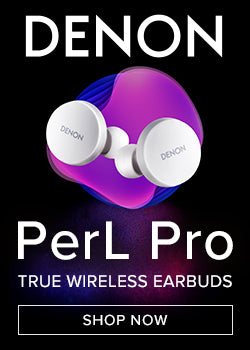










 Home Theater
Home Theater Speakers
Speakers Tower Speakers
Tower Speakers
 Bookshelf Speakers
Bookshelf Speakers
 Center Channel Speakers
Center Channel Speakers
 Wall & Ceiling Speakers
Wall & Ceiling Speakers
 Surround Speakers
Surround Speakers
 Dolby Atmos Speakers
Dolby Atmos Speakers
 Subwoofers
Subwoofers
 Soundbars
Soundbars
 Speaker Stands & Mounts
Speaker Stands & Mounts
 Components
Components Home Theater Receivers
Home Theater Receivers
 Surround Sound Processors
Surround Sound Processors
 Power Amps
Power Amps
 Movie Sources
Movie Sources
 TVs & Projectors
TVs & Projectors Televisions
Televisions
 Projectors
Projectors
 Projector Screens
Projector Screens
 TV & Projector Mounts
TV & Projector Mounts
 Seating & Furniture
Seating & Furniture Home Theater Seating
Home Theater Seating
 Media Cabinets
Media Cabinets
 A/V Racks & Shelves
A/V Racks & Shelves
 Accessories
Accessories
 Acoustic Treatments
Acoustic Treatments Absorption Panels
Absorption Panels
 Bass Trap Panels
Bass Trap Panels
 Diffusion Panels
Diffusion Panels
 Acoustic Treatment Packages
Acoustic Treatment Packages
 Cables & Accessories
Cables & Accessories HDMI Cables
HDMI Cables
 Analog Cables
Analog Cables
 Digital Cables
Digital Cables
 USB Cables
USB Cables
 Speaker Cables
Speaker Cables
 Subwoofer Cables
Subwoofer Cables
 Power Management
Power Management
 Featured & Deals
Featured & Deals Best Sellers
Best Sellers
 Sale
Sale
 Home Audio
Home Audio Outdoor Speakers
Outdoor Speakers
 Portable & Bluetooth
Portable & Bluetooth
 Wireless Speaker Systems
Wireless Speaker Systems
 Computer Speakers
Computer Speakers
 Powered Speakers
Powered Speakers
 Integrated Amplifiers
Integrated Amplifiers
 Power Amplifiers
Power Amplifiers
 Stereo Preamplifiers
Stereo Preamplifiers
 Stereo Receivers
Stereo Receivers
 Streaming Media Players
Streaming Media Players
 Digital-to-Analog Converters
Digital-to-Analog Converters
 CD Players
CD Players
 Outdoor Entertainment
Outdoor Entertainment Outdoor Subwoofers
Outdoor Subwoofers
 Turntables
Turntables Manual
Manual
 Automatic
Automatic
 Phono Cartridges
Phono Cartridges Moving Coil
Moving Coil
 Moving Magnet
Moving Magnet
 Moving Iron
Moving Iron
 Mono
Mono
 Phono Preamps
Phono Preamps MC Compatible
MC Compatible
 MM Compatible
MM Compatible
 Record Cleaning & Care
Record Cleaning & Care Stylus Care
Stylus Care
 Cleaning Machines
Cleaning Machines
 Record Cleaning Fluid
Record Cleaning Fluid
 Record Sleeves
Record Sleeves
 Isolation Systems
Isolation Systems Turntable Setup Tools
Turntable Setup Tools
 Turntable Cables
Turntable Cables
 Record Weights
Record Weights
 Turntable Mats
Turntable Mats
 Headphones
Headphones In-Ear Headphones
In-Ear Headphones
 On-Ear Headphones
On-Ear Headphones
 Over-Ear Headphones
Over-Ear Headphones
 Wireless Headphones
Wireless Headphones
 Gaming Headsets
Gaming Headsets
 Headphone Amps & DACs
Headphone Amps & DACs Digital Audio Players
Digital Audio Players
 Smart Home
Smart Home Deals
Deals Limited Time Deals
Limited Time Deals Deals by Category
Deals by Category